#global medical tourism market
Explore tagged Tumblr posts
Text

Factors Propelling the global medical tourism market
We will dive deep into the major trends into this global industry, the challenges impacting cross-border patient flow, and some of the most significant shifts in the global medical tourism market.
0 notes
Text
Unveiling the Titans of the Medical Tourism Industry
The realm of medical tourism, where individuals embark on international journeys for superior healthcare, is witnessing an unprecedented surge in popularity. Among the myriad choices available, certain key players have emerged as giants in this thriving industry, setting standards for quality and innovation.
Bumrungrad International Hospital (Thailand):
Towering over Bangkok, Thailand, Bumrungrad International Hospital has etched its name as a pioneer in the medical tourism landscape. Renowned for its cutting-edge facilities and a diverse team of experts, Bumrungrad annually treats over 520,000 international patients. Boasting services across 70 medical specialties, the hospital is accredited by the prestigious Joint Commission International (JCI).

Click Here to know more about: Medical Tourism Industry
Apollo Hospitals (India):
In the heart of India's healthcare renaissance, Apollo Hospitals stands tall with over 2 million international patients treated since its inception. With a network comprising over 70 hospitals both in India and globally, Apollo is the first in the country to receive accreditation from the esteemed JCI. The hospital group excels in various specialties, including organ transplantation, oncology, and fertility treatments.
Anadolu Medical Center (Turkey):
Nestled in Istanbul, Turkey, Anadolu Medical Center has become a beacon for medical tourists. Treating patients from over 100 countries annually, the center boasts a remarkable 90% success rate in bone marrow transplants. Accredited by both JCI and the European Foundation for Quality Management (EFQM), Anadolu Medical Center is synonymous with top-notch healthcare.
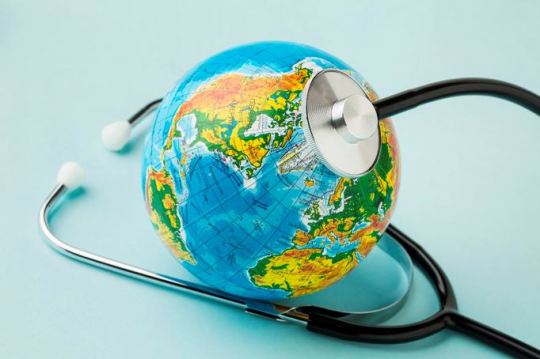
Unlock medical tourism industry success: explore our reports now!
Singapore General Hospital (Singapore):
Singapore's prowess in medical tourism is epitomized by Singapore General Hospital (SGH). Treating over 400,000 international patients yearly, SGH is a government-owned institution known for its excellence in neurology, gastroenterology, and transplantation. The hospital is accredited by JCI and Singapore's Council for Accreditation, ensuring adherence to global standards.
Mayo Clinic (United States):
Breaking traditional norms, the Mayo Clinic in Rochester, Minnesota, has become a beacon for international patients seeking top-tier medical care. Welcoming patients from over 140 countries, the clinic sees an annual influx of 1.3 million individuals. Consistently ranked among the top hospitals in the United States, the Mayo Clinic is synonymous with groundbreaking medical research and treatment.
Conclusion:
As the medical tourism industry continues its meteoric rise, these top players – Bumrungrad International Hospital, Apollo Hospitals, Anadolu Medical Center, Singapore General Hospital, and the Mayo Clinic – stand as pillars of excellence. Their commitment to providing world-class healthcare is evident not just in the quality of their services but also in the remarkable statistics that underscore their global impact. In the evolving landscape of medical tourism, these titans are shaping the future of cross-border healthcare services, making them the go-to destinations for those seeking superior medical treatment.
#market research#business#ken research#market analysis#market report#medical tourism growth#medical tourism market trends#medical tourism market share#medical tourism market report#medical tourism revenue#global health tourism market#medical tourism market size#global medical tourism market#health tourism industry#medical tourism services#medical tourism industry#medical tourism market#medical tourism companies#medical tourism
0 notes
Text
Healthcare Industry in India | UJA Market Report
The Indian healthcare sector is one of the largest sectors in terms of both revenue and employment.
The Indian healthcare industry is experiencing remarkable growth, with private equity and venture capital investments exceeding INR 84.3 billion in the first five months of 2024 alone, reflecting a 220% increase compared to the previous year.
The hospital industry in India accounts for 80% of the total healthcare market.
With a compound annual growth rate (CAGR) exceeding 8%, India’s hospital industry is projected to reach INR 16,315.6 billion by 2032.
#largest sectors#healthcare industry#healthcare sectors#healthcare market#hospital sector#Medical Tourism#Ayushman Bharat Yojana#health insurance sector#Pradhan Mantri Swasthya Suraksha Yojana#uja global advisory#uj
0 notes
Text
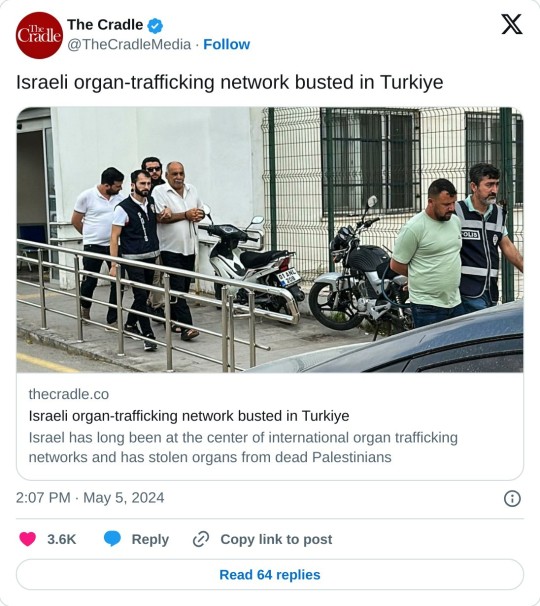
Police in the Turkish city of Adana detained 11 suspects, five Israeli and two Syrian, on allegations of organ trafficking, the Daily Sabah reported on 5 May. The Provincial Directorate of Security's Anti-Smuggling and Border Gates Branch began investigating after examining the passports of seven individuals who arrived in Adana from Israel about a month ago by plane for the purpose of health tourism. The two Syrian nationals, ages 20 and 21, were found to have fake passports. Further investigation revealed that Syrian nationals had each agreed to sell one of their own kidneys to two of the Israeli nationals, ages 68 and 28, for kidney transplants in Adana. During searches at the suspects' residences, $65,000 and numerous fake passports were seized. Israel has long been at the center of what Bloomberg described in 2011 as a “sprawling global black market in organs where brokers use deception, violence, and coercion to buy kidneys from impoverished people, mainly in underdeveloped countries, and then sell them to critically ill patients in more-affluent nations.” The financial newspaper added, “Many of the black-market kidneys harvested by these gangs are destined for people who live in Israel.” The organ-trafficking network extends from former Soviet Republics such as Azerbaijan, Belarus, Ukraine, and Moldova to Brazil, the Philippines, South Africa, and beyond, the Bloomberg investigation showed. Accusations of Israeli involvement in organ trafficking also apply to the occupied Palestinian territories. In 2009, Sweden's largest daily newspaper, Aftonbladet, reported testimony that the Israeli army was kidnapping and murdering Palestinians to harvest their organs. The report quotes Palestinian claims that young men from the occupied West Bank and Gaza Strip had been seized by the Israeli army, and their bodies returned to the families with missing organs. "'Our sons are used as involuntary organ donors,' relatives of Khaled from Nablus said to me, as did the mother of Raed from Jenin as well as the uncles of Machmod and Nafes from Gaza, who all had disappeared for a few days and returned by night, dead and autopsied," wrote Donald Bostrom, the author of the report.Bostrom also cites an incident of alleged organ theft during the the first Palestinian intifada in 1992. He says that the Israeli army abducted a young man known for throwing stones at Israeli troops in the Nablus area. The young man was shot in the chest, both legs, and the stomach before being taken to a military helicopter, which transported him to an unknown location. Five nights later, Bostrom said, the young man's body was returned, wrapped in green hospital sheets. Israel’s Channel 2 TV reported that in the 1990s, specialists at Abu Kabir Forensic Medicine Institute harvested skin, corneas, heart valves, and bones from the bodies of Israeli soldiers, Israeli citizens, Palestinians, and foreign workers without permission from relatives. The Israeli military confirmed that the practice took place, but claimed, "This activity ended a decade ago and does not happen any longer." Israel’s assault on Gaza since 7 October has provided further opportunities for the theft and harvesting of Palestinians’ organs. On 30 January, WAFA news agency reported that the Israeli army returned the bodies of 100 Palestinian civilians it had stolen from hospitals and cemeteries in various areas in Gaza. According to medical sources, inspection of some of the bodies showed that organs were missing from some of them. On 18 January, the Times of Israel reported that the Israeli army confirmed reports that its soldiers dug up graves in a Gaza cemetery, claiming its soldiers were trying to “confirm that the bodies of hostages were not buried there.”
#yemen#jerusalem#tel aviv#current events#palestine#free palestine#gaza#free gaza#news on gaza#palestine news#news update#war news#war on gaza#human rights#war crimes#gaza genocide#genocide
6K notes
·
View notes
Text
TL;DR Project 2025
Project 2025 has crossed my dash several times, so maybe tumblr is already informed about the hellish 900-page takeover plan if Trump wins office again. But even the articles covering Project 2025 can be a LOT of reading. So I'm trying to get it down to simple bulleted lists…
Navigator Research (a progressive polling outfit) found that 7 in 10 Americans are unfamiliar with Project 2025. But the more they learn about it, the more they don't like or want it. When asked about a series of policy plans taken directly from Project 2025, the bipartisan survey group responded most negatively to the following:
Allowing employers to stop paying hourly workers overtime
Allowing the government to monitor people’s pregnancies to potentially prosecute them if they miscarry
Removing health care protections for people with pre-existing conditions
Eliminating the National Weather Service, which is currently responsible for preparing for extreme weather events like heat waves, floods, and wildfires
Eliminating the Head Start program, ending preschool education for the children of low-income families
Putting a new tax on health insurance for millions of people who get insurance through their employer
Banning Medicare from negotiating for lower prescription drug costs and eliminating the $35 monthly cap on the price of insulin for seniors
Cutting Social Security benefits by raising the retirement age
Allowing employers to deny workers access to birth control

Laurie Garrett looked at the roughly 50 pages within Project 2025 that deal with Health and Human Services (HHS) and other health agencies, and summarized them on Twitter/X in a series of replies. I've shortened even more here:
HHS must "respect for the sacred rights of conscience" for Federal workers & healthcare providers and workers broadly who object to abortions, contraception, gender reassignment & other issues - ie. allow them to deny services based on religious beliefs
HHS should promote "stable and flourishing married families."
Require all welfare programs to "promote father involvement" – or terminate their funding for mothers and children.
Prioritize adoptions via faith-based organizations.
Redefine sex, eliminating all forms of gender "confusion" regarding identity and orientation.
Eliminate the Head Start program for children, entirely
Ban all funding of Planned Parenthood
Ban birth control services that are "egregious attacks on many Americans' religious & moral beliefs"
Deny pregnancy termination pills, "mail-order abortions."
Eliminate Office of Refugee Resettlement; move all refugee matters to the Department of Homeland Security
Healthcare should be "market-based"
Ban all mask and vaccine requirements.
Closely regulate the NIH w/citizen ethics panels, ensuring that no research involves fetal tissue, leads to development of new forms of Abortions or brings profits to the researchers.
Redirect the Office of Global Affairs to promoting "moral conscience" & full compliance w/the Mexico City policy
The CDC should have no role in medical policies.
"Because liberal states have now become sanctuaries for abortion tourism," HHS should use every available tool, including the cutting of funds, to ensure that every state reports exactly how many abortions take place within its borders, at what gestational age of the child, for what reason, the mother’s state of residence & by what method.
I'm still looking for a good short summary of the environmental horrors that Project 2025 would bring if it comes to fruition…
311 notes
·
View notes
Text
Top Business Ideas in the UAE for Entrepreneurs
Starting a business in UAE is an exciting venture, as the country offers numerous opportunities across various sectors. The UAE is home to some of the most lucrative industries in the world, whether you're an experienced professional looking for new growth opportunities or an aspiring entrepreneur searching for the ideal niche. There is a lot of potential to tap into, including in the areas of real estate, e-commerce, tourism, healthcare, and IT. We'll look at the best business concepts in this blog to help you start a profitable company in the United Arab Emirates.
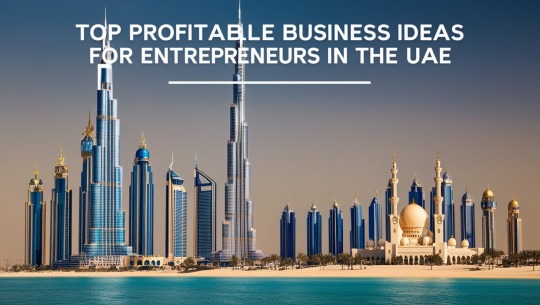
Why Entrepreneurs Find Success in the United Arab Emirates
In addition to being a prime location for companies, the UAE provides an environment that encourages development and creativity. It is a desirable location for entrepreneurs due to its tax-free zones, sophisticated infrastructure, and business-friendly laws. Whether you're looking to launch a local business or expand your global reach, the UAE is the place to be. However, which industries are the most lucrative and appropriate for would-be business owners?
Profitable Sectors for Starting a Business in the UAE
1. Real Estate
One of the most profitable industries in the UAE is real estate, and international investors are drawn to Dubai and Abu Dhabi on a regular basis. The nation is the perfect place for real estate services and property investment because of its expanding population, influx of tourists, and creation of famous landmarks.
Innovative Business Ideas in Real Estate:
Property Management Services: Providing property management services can be a profitable choice in an ever-growing market.
Real estate brokerage: Helping foreign customers purchase or rent real estate can generate a consistent income in this cutthroat industry.
Flexible office spaces are becoming more and more in demand as the entrepreneurial culture expands.
2. E-Commerce
Due to the widespread use of smartphones and the growing number of tech-savvy people, the e-commerce sector has grown rapidly in recent years. Starting a business in UAE’s e-commerce market can be an excellent choice, especially as the country embraces digital transformation.
Innovative Business Ideas in E-Commerce:
Online Retail Store: Selling specialized goods, such as electronics or clothing, can give you a firm footing in this cutthroat market.
Marketplace Platforms: In order to take advantage of the UAE's booming retail industry, establish a platform for local vendors to sell goods online.
Subscription Boxes: Provide specialized subscription boxes for niche markets, such as gourmet foods, wellness, or cosmetics.
3. Tourism
With millions of tourists visiting the UAE each year, tourism plays a major role in the economy of the nation. There are plenty of options for entrepreneurs with sights like the Palm Jumeirah, the Burj Khalifa, and the desert safari experiences.
Innovative Business Ideas in Tourism:
Luxury Travel Services: Provide wealthy people with unique and personalized travel packages.
Services for Tour Operators: Focus on speciality tours, like eco-tourism, adventure, or cultural experiences.
Travel Technology Solutions: Offer cutting-edge platforms or applications for travel that improve visitors' experiences.
4. Healthcare
The UAE's healthcare industry is expanding quickly, with an emphasis on offering both locals and visitors top-notch medical care. The government's drive for top-notch medical facilities and health technology innovation can help entrepreneurs in the healthcare sector.
Innovative Business Ideas in Healthcare:
Offering online medical consultations and healthcare services, telemedicine has become more and more popular in the post-pandemic world.
Fitness and Wellness: Open a yoga studio, fitness center, or wellness app to appeal to the health-conscious population in the United Arab Emirates.
Medical Equipment Supply: Provide medical devices and equipment to clinics, hospitals, or home care agencies.
5. IT and Technology
Fintech, AI, blockchain, and cybersecurity are among the rapidly growing tech-driven industries in the United Arab Emirates.. Starting a business in UAE in the IT sector is a smart move, as the government is heavily investing in technological infrastructure.
Innovative Business Ideas in IT:
AI Solutions: Create AI-driven solutions for companies in a range of industries, including retail, healthcare, and real estate.
Cybersecurity Services: Provide cybersecurity services to companies that want to safeguard their systems and data in a world that is digitizing quickly.
Blockchain Solutions: Develop blockchain-based software for logistics, finance, or supply chain management.
How to Enter These Markets
Understanding the local market, adhering to legal and regulatory requirements, and making the appropriate technological and infrastructure investments are all crucial for capitalizing on these lucrative industries. Starting a business in UAE requires careful planning, market research, and a solid business strategy. Operating in one of the numerous free zones can provide substantial tax benefits and streamlined business setup procedures for foreign business owners.
Start Your Business in the United Arab Emirates
Are you prepared to begin your business endeavors in the United Arab Emirates? The UAE provides business owners with a multitude of options, regardless of their interests in IT, e-commerce, real estate, or healthcare. Working with a reputable business setup company that can help you navigate local regulations and guide you through the process is essential to turning your vision into a reality.
Starting a business in UAE has never been easier. Establishing a successful business in one of the most dynamic and business-friendly environments in the world is possible with the correct business idea, strategy, and support.
#StartingABusinessInUAE#UAEEntrepreneurs#BusinessIdeasUAE#UAEStartups#EntrepreneurshipInUAE#UAEOpportunities#ProfitableBusinessesUAE#DubaiBusinessIdeas#BusinessSetupUAE#EntrepreneurialSuccess
3 notes
·
View notes
Text
Why You Should Start Your Own Travel Agency and Travel Portal

Starting your own travel agency and travel portal in India presents a unique set of opportunities and advantages, given the country's vast and diverse tourism landscape. Here's why having the travel agency and travel portal is a great idea to embark on this entrepreneurial journey in India:
START YOUR OWN TRAVEL AGENCY & TRAVEL PORTAL.
1. Growing Tourism Industry in India
India's tourism industry is booming, with both domestic and international tourism on the rise. The country offers a rich tapestry of experiences, from heritage sites, cultural festivals, and wildlife safaris to spiritual journeys, adventure tourism, and wellness retreats. The Indian government has also been proactive in promoting tourism through initiatives like the Incredible India campaign and the development of infrastructure, making it an opportune time to start a travel business.
2. Diverse Market Segments
India's diverse geography and culture create a wide range of market segments to tap into. Whether its luxury travel, budget tourism, eco-tourism, medical tourism, or adventure sports, you can specialize in a niche that aligns with your passion and expertise. For instance, spiritual tourism, which includes visits to holy cities like Varanasi, Rishikesh, and Amritsar, is a particularly lucrative segment in India.
3. Growing Middle Class and Disposable Income
India's middle class is expanding rapidly, with increasing disposable income and a growing appetite for travel. More Indians are now willing to spend on vacations, both within the country and abroad. This rising demand for travel services opens up a significant market for travel entrepreneurs who can offer tailored experiences that cater to different budgets and preferences.
4. Technology and Digital Adoption
India has witnessed a surge in digital adoption, with more people using smartphones and the internet for various services, including travel bookings. The proliferation of online payment systems, travel apps, and e-commerce platforms has made it easier for businesses to reach customers. By creating a well-designed travel portal, you can tap into this digitally savvy audience, offering convenience and personalized services.
5. Opportunities in Domestic Tourism
The COVID-19 pandemic has shifted travel preferences, with a growing emphasis on domestic tourism. Indians are increasingly exploring their own country, discovering hidden gems in offbeat destinations. This trend offers a great opportunity to cater to domestic tourists, offering curated experiences, staycations, and weekend getaways that highlight India's lesser-known attractions.
6. Supportive Government Policies
The Indian government has been supportive of the tourism sector, offering various incentives and policies to encourage entrepreneurs. The introduction of e-Visas, the Swadesh Darshan Scheme for theme-based tourist circuits, and the development of tourism infrastructure are just a few examples of government initiatives aimed at boosting the industry. These policies can help you in establishing and growing your travel business.
7. Cultural and Heritage Tourism
India's rich cultural heritage is a major draw for tourists from around the world. The country is home to 40 UNESCO World Heritage Sites, including the Taj Mahal, Qutub Minar, and the Ajanta and Ellora Caves. Starting a travel business that focuses on cultural and heritage tourism allows you to tap into a global market of travelers interested in history, architecture, and traditional arts.
8. Potential for Innovation and Differentiation
The Indian travel market is vast, but there is still room for innovation. You can differentiate your travel business by offering unique experiences, such as rural tourism, culinary tours, or wellness retreats that cater to niche audiences. By leveraging local knowledge and connections, you can create authentic experiences that stand out in a crowded market.
9. Entrepreneurial Ecosystem
India's entrepreneurial ecosystem is thriving, with numerous resources available to support startups. From incubators and accelerators to funding opportunities and mentorship programs, there are various avenues to help you launch and scale your travel business. The availability of skilled professionals in fields like technology, marketing, and customer service also makes it easier to build a strong team.
10. Personal Fulfillment and Contribution to Society
Starting a travel business in India can be personally fulfilling, especially if you have a passion for travel and exploration. Beyond personal satisfaction, you can also make a positive impact by promoting sustainable tourism practices, supporting local communities, and preserving India's natural and cultural heritage. Your business can contribute to the socio-economic development of regions that rely on tourism as a major source of income.
Conclusion
India's dynamic and diverse tourism landscape, coupled with a growing middle class, digital adoption, and supportive government policies, makes it an ideal market to start a travel business and portal. By offering unique and tailored experiences, you can tap into the vast potential of the Indian travel market and build a successful and fulfilling business that caters to the evolving needs of travelers.
We INFINITY WEBINFO PVT LTD are expert in Travel Portal and Travel Websites. We are also experts In API Integration, B2B, B2C and White label portals.
To Start You Journey With us Contact now:-
Mobile: – +91 9711090237
#travel portal solutions#travel portal development#travel portal company#white label solution#white label travel portal travel portal#travel agents#travel website#tour and travel#travel agency online#b2c portal#b2b portal#white label
2 notes
·
View notes
Text
The Rise of 3D Printing in Prosthetics and Orthotics Market
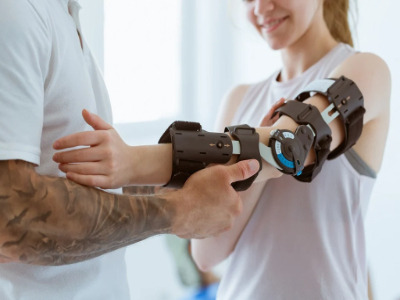
The global prosthetics and orthotics market plays a vital role in improving quality of life for millions worldwide. Worth an estimated $7.2 billion in 2024, the market facilitates mobility for those with limb differences or injuries through highly customized external limb replacements and braces. The market introduces prosthetics and orthotics—Medical devices that enhance or assist impaired body parts and mobility. Orthotics are braces or supports for joints, spine, and limbs; prosthetics externally replace missing limbs. Together they improve functionality and quality of life for users. Major players in the prosthetics and orthotics space utilizing advanced manufacturing include Ossur, Steeper Group, Blatchford, Fillauer, Ottobock, and WillowWood Global. These industry leaders increasingly deploy cutting-edge 3D printing and customized design software to produce state-of-the-art prosthetics and braces. Current trends in the prosthetics and orthotics market include growing utilization of 3D printing and advanced manufacturing techniques. 3D printing enables on-demand production of complex, customized devices. It reduces manufacturing costs and wait times while improving fit and comfort. Expanding material options also allow more lifelike prosthetics. As technology evolves, the market is positioned for continued growth through 2031 in facilitating mobility worldwide. Future Outlook The prosthetics and orthotics market is expected to witness significant advancements in the coming years. Manufacturers are constantly focusing on developing innovative technologies such as 3D printed prosthetics that provide a better fit, enhanced comfort, and unrestricted movement. There is also a rising trend of using lightweight, highly durable and comfortable materials like carbon fiber and thermoplastics to manufacture prosthetic devices. Advancements in myoelectric prosthetics with touch and motion sensors are making them more dexterous and responsive. Using pattern recognition and machine learning techniques, next-gen prosthetics could gain functionality approaching that of natural limbs.
PEST Analysis Political: Regulations regarding clinical trials and approvals of new prosthetic technologies may affect market growth. Favorable reimbursement policies for prosthetic devices can boost adoption. Economic: Rising disposable incomes allow more individuals to opt for higher-end prosthetics. Emerging markets present abundant opportunities for growth. Inflation and economic slowdowns can hinder market profitability. Social: Increasing incidence of amputations and disabilities due to aging population, accidents, war injuries etc. drive market demand. Growing awareness regarding prosthetics and orthotics aids adoption. Stigma associated with limb loss poses challenges. Technological: Advancements in materials, manufacturing techniques like 3D printing, sensors, computing power and battery technologies are enhancing functionality and usability of prosthetics/orthotics. Myoelectric and robotic prosthetics have vastly improved in recent years. Opportunity Rising aging population presents a huge opportunity for prosthetics and orthotics targeting mobility issues and disabilities. Over 630,000 amputations occur annually in the U.S. due to dysvascular conditions like diabetes, presenting a sizable patient pool. Expanding applications of prosthetics and orthotics beyond mobility impairment into sports and military could drive significant growth. Growing incidence of trauma and injuries globally increases the number of patients relying on these devices. Emerging markets like Asia Pacific and Latin America offer immense opportunities owing to increasing disposable incomes, expanding healthcare infrastructure and rising medical tourism. Technological advancements are constantly improving functionality and usability of prosthetic devices, fueling adoption rates. The lightweight, durable and comfortable characteristics of newer materials expand addressable indications and patient acceptance. Key Takeaways Growing demand from aging population: The rapid increase in aging population worldwide who are prone to mobility issues, disabilities and chronic diseases like diabetes is a key driver spurring sales of orthotic and prosthetic devices. Global expansion into emerging markets: Emerging markets like Asia Pacific, Latin America, Eastern Europe and the Middle East offer immense opportunities owing to their large population bases and improving healthcare penetration. Technological advancements: Constant R&D bringing advancements in areas such as 3D printing, lightweight materials,
4 notes
·
View notes
Text

💥 … Israeli organ trafficking network!! New? — not really!! They mess with them in every imaginable way!!
By: LaillaB, founder of ‘Reclaim the Narrative’, from LinkedIn …
“Police in the Turkish city of Adana detained 11 suspects, five Israeli and two Syrian, on allegations of organ trafficking, the Daily Sabah reported on 5 May.
The Provincial Directorate of Security’s Anti-Smuggling and Border Gates Branch began investigating after examining the passports of seven individuals who arrived in Adana from Israel about a month ago by plane for the purpose of health tourism.
The two Syrian nationals, ages 20 and 21, were found to have fake passports and further investigation revealed that Syrian nationals had each agreed to sell one of their own kidneys to two of the Israeli nationals, ages 68 and 28, for kidney transplants in Adana.
During searches at the suspects’ residences, $65,000 and numerous fake passports were seized.
Israel has long been at the center of what Bloomberg described in 2011 as a “sprawling global black market in organs where brokers use deception, violence, and coercion to buy kidneys from impoverished people, mainly in underdeveloped countries, and then sell them to critically ill patients in more-affluent nations.”
The financial newspaper added, “Many of the black-market kidneys harvested by these gangs are destined for people who live in Israel.”
In 2009, Sweden’s largest daily newspaper, Aftonbladet, reported testimony that the Israel was kidnapping and murdering Palestinians to harvest their organs.
The report quotes Palestinian claims that young men from the occupied West Bank and Gaza Strip had been seized by Israel, and their bodies returned to the families with missing organs.
“‘Our sons are used as involuntary organ donors,’ relatives of Khaled from Nablus told me, as did the mother of Raed from Jenin as well as the uncles of Machmod and Nafes from Gaza, who all had disappeared for a few days and returned by night, dead and autopsied,” wrote Donald Bostrom, the author of the report.
Israel’s Channel 2 TV reported that in the 1990s, Abu Kabir Forensic Medicine Institute harvested skin, corneas, heart valves, and bones from the bodies of Israeli soldiers, Israeli citizens, Palestinians, and foreign workers without permission from relatives.
The Israeli military confirmed that the practice took place but claimed, “This activity ended a decade ago and does not happen any longer.”
Israel’s assault on Gaza since 7 Oct has provided further opportunities for the theft and harvesting of Palestinians’ organs.
On 18 Jan, the Times of Israel reported that Israel confirmed reports that its soldiers dug up graves in a Gaza cemetery, claiming its soldiers were trying to “confirm that the bodies of hostages were not buried there.”
On 30 Jan, WAFA news agency reported that Israel returned the bodies of 100 Palestinians it had stolen from hospitals and cemeteries in various areas in Gaza. According to medical sources, inspection of some of the bodies showed that organs were missing from some of them.
Here we don't pray for the weak, we prey on the weak.” … 💥
#reclaimthenarrative —🕊🍉 — #FreePalestine … @hrexach …
#dr rex equality news information education#graphic source#graphic#graphics#hortyrex ©#horty#quote#it is what it is#linkedin#war criminals#war crimes#war#gaza genocide#palestine#human trafficking#israel terrorist#israhell#israel
3 notes
·
View notes
Text
EXPLORE HONGKONG

Dream destination: HONGKONG
Hong Kong has always been a favorite destination of tourists, especially of Filipino travelers, as it offers something for everyone--from attractions to food to shopping destinations.
“Hong Kong has always been close to the hearts of Filipino travelers and it is one of Philippines' top travel destinations of choice,” Hong Kong Tourism Board regional director of Southeast Asia Raymond Chan said during the "Marvels in Hong Kong" media event.
The pandemic put a pause on travel for the past two years, but with restrictions slowly easing up globally, tourists have a chance to visit Hong Kong again.
Chan noted that the "0+3 travel measures" is a “significant milestone for Hong Kong.”
“Currently, visitors to Hong Kong are no longer required to undergo hotel quarantine with three-day medical surveillance period,” he explained.
But despite the hitch in global travel, Hong Kong continued to develop its tourism facilities and destinations in the past years to ensure tourists will have something new to look forward to when they return.
history
Hong Kong is a special administrative region (SAR) of the People's Republic of China. It comprises 200 islands located in Eastern Asia bordering the South China Sea and China. Much of Hong Kong's terrain is hilly to mountainous with steep slopes. The government system is a limited democracy; the chief of state is the president of China, and the head of government is the chief executive of Hong Kong. Hong Kong has a free market economy in which the prices of goods and services are determined in a free price system. Hong Kong is a member of the Asia-Pacific Economic Cooperation (APEC).
Hong Kong was established as a colony of the British Empire after the Qing Empire ceded Hong Kong Island in 1841–1842. The colony expanded to the Kowloon Peninsula in 1860 and was further extended when the United Kingdom obtained a 99-year lease of the New Territories in 1898. Hong Kong was briefly occupied by Japan from 1941 to 1945 during World War II. The whole territory was transferred from the United Kingdom to China in 1997. Hong Kong maintains separate governing and economic systems from that of mainland China under the principle of "one country, two systems".[f]
Originally a sparsely populated area of farming and fishing villages,[18][19] the territory is now one of the world's most significant financial centres and commercial ports. Hong Kong is the world's fourth-ranked global financial centre, ninth-largest exporter, and eighth-largest importer. Its currency, the Hong Kong dollar, is the eighth most traded currency in the world. Home to the second-highest number of billionaires of any city in the world, Hong Kong has the largest concentration of ultra high-net-worth individuals. Although the city has one of the highest per capita incomes in the world, severe income inequality exists among the population. Despite having the largest number of skyscrapers of any city in the world, housing in Hong Kong has been well-documented to experience a chronic persistent shortage.
Hong Kong is a highly developed territory and has a Human Development Index (HDI) of 0.952, ranking fourth in the world. The city has the highest life expectancy in the world, and a public transport rate exceeding 90%.
Avenue of stars

There was a time when Hong Kong’s filmic output was only bested by Hollywood and Bollywood, and while it’s a less prodigious beast these days, the city’s film industry still once produced illustrious names like Bruce Lee, Jackie Chan, Jet Li, the Shaw Brothers, John Woo, and Wong Kar-wai. Avenue of Stars pays tribute to these figures and many others who have helped burnish Hong Kong’s cinematic legacy. Selfie opportunities come with sculptures of Hong Kong legends such as martial arts master Bruce Lee, as well as singer and actress Anita Mui. Even Hong Kong's beloved local cartoon character McDull has a prime spot in front of the Victoria Harbour skyline. Plus, you can check out over 100 handprint plaques set into the wooden handrails along the waterfront.
Theme parks and attractions
It's impossible to talk about Hong Kong and not mention the "'happiest place on Earth."
Hong Kong Disneyland recently unveiled its new Castle of Magical Dreams and even started its new light show, “Momentous

Hong Kong Cuisine
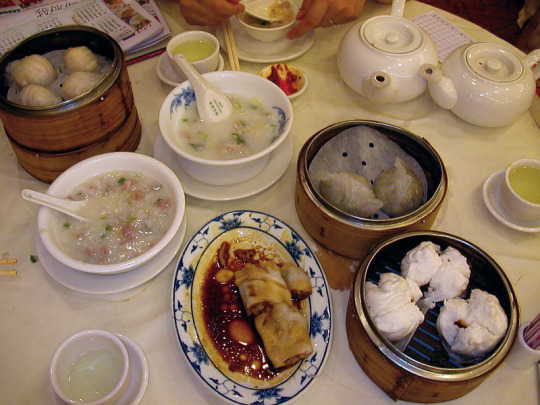
Traditional Hong Kong food hails from the Guangdong Province of China, with the most popular Cantonese dishes consisting of poultry, meat, or seafood alongside rice or noodles and some kind of preserved or pickled vegetables. You’ll find when eating in Hong Kong that there is a dominant sharing culture – most groups order a large meal to be shared together. Street food is also a very significant part of Cantonese food culture in Hong Kong. You’re sure to discover many street stalls selling delicious smelling, often deep fried, foods and snacks!
The culture of hongkong

The culture of Hong Kong is primarily a mix of Chinese and Western influences, stemming from Lingnan Cantonese roots and later fusing with British culture due to British colonialism (Jyutping: Jyut6 zeoi6; Traditional Chinese: 粵英薈萃). As an international financial center dubbed "Asia's World City", contemporary Hong Kong has also absorbed many international influences from around the world. Moreover, Hong Kong also has indigenous people and ethnic minorities from South and Southeast Asia, whose cultures all play integral parts in modern day Hong Kong culture. As a result, after the 1997 transfer of sovereignty to the People's Republic of China, Hong Kong has continued to develop a unique identity under the rubric of One Country, Two Systems.
Hong Kong cultural festivals include Chinese New Year, the Dragon Boat Festival, the Mid-Autumn Festival, Christmas and the Western New Year. Expats can expect a great atmosphere at these events which usually involve impressive firework displays. As a city, Hong Kong also enjoys many other cultural events ranging from traditional Cantonese to other Chinese regional operas, theatre productions, ballet performances and music shows.
Hongkong festival

Hong Kong festivals are often lavish affairs with street parades, packed temples, traditional music and dance performances. Chinese New Year is the most important celebration in Hong Kong and many Asian countries, but the city also has plenty of unique festivals you might not find elsewhere.
Buddhist and Taoist events are observed according to the lunar calendar, which means that the dates shift on a yearly basis. Some of Hong Kong’s biggest festivals usually take place in January or February (Chinese New Year), May, and October. It’s best to book your flights and accommodation far in advance as prices tend to soar during these months.
How to get there
Several local airlines such as Air Asia Philippines, Cebu Pacific Air, and Philippine Airlines fly direct several times daily to Hong Kong from Manila departing at Ninoy Aquino International Airport (NAIA). Non-stop flight time from Manila to Hong Kong is around 2 hours 15 minutes.
Budget for Air Asia Philippines : P3,300
Philippine travel tax: P2,500
Where to stay

Welcome to The Park Lane Hong Kong, a Pullman Hotel
As soon as you enter the spacious lobby, you will be greeted by captivating digital artworks displayed on large screens. The lobby also showcases exhibitions from the Artist Playground, a Pullman initiative that introduces various artists over time. The hotel offers a blend of art, travel, culture, and technology, ensuring a fulfilling stay. For digital-savy guests, make use of our check-in/out robots to easily check in and check out. Enjoy seamless high-speed Wi-Fi access throughout the hotel. Immerse yourself in a luminous world that harmoniously reflects the essence of Hong Kong and the local lifestyle
Budget for accommodations: P3,000 for 4 nights
Where to eat
Wonton noodles at Mak’s Noodle
The staple of Southeastern China, this delicious brothy delight is common in Hong Kong and can be a thrilling experience if you know where to get it! Typically shrimp, pork and vegetable wrapped in a neat package of thing and springy wonton egg-noodle dough, these little dumpling-like parcels are cooked al dente before being perched atop a steaming hot flavour-filled umami broth. A sprinkle of chopped chives completes the dish which when served should be devoured noodle first to keep your wonton from going soggy. When on the hunt for where to eat in Hong Kong, particularly where to eat wonton noodles, head to Mak’s Noodle – arguably the most renowned noodle shop in the city
Budget for food: S$5 (P175/meal) x 2 meals/day x 5 days = P1,400
How To Get Around

The Mass Transit Railway (known as the MTR) is the fastest and most convenient mode of transport in the urban areas. Serving an average of 4.8 million passengers a day, the MTR covers much of the New Territories, Kowloon and the harbour front of Hong Kong Island, with the latest expansion now including stations at Sai Ying Pun, the University of Hong Kong and Kennedy Town. The Island Line is planned to be extended further south to Aberdeen in 2016, transporting passengers to Ocean Park, a major tourist attraction in the city, as well as Wong Chuk Hang and South Horizons. Other extension plans include Shatin to Central via To Kwa Wan and an express railway linking Hong Kong to Guangzhou and Beijing.
Budjet for transportation : P910
What To See and Do
Spending 5 days in Hong Kong gives you plenty of time to see the top sights & attractions, while not needing to rush through it all. You will be able to take full advantage of your days & nights in Hong Kong, and have the flexibility to move things around as you see fit.
Budjet for attractions: P980
Total budget
P3,300 – Air Asia Philippines
P2,500 – Philippine travel tax
P3,000 – Accommodations
P1,400 – Food
P910 – Transportation
P980 – Attractions
——
P12,090 – TOTAL
Reference:
https://en.m.wikipedia.org/wiki/Hong_Kong
https://en.m.wikipedia.org/wiki/Hong_Kong#:~:text=Hong%20Kong%20was%20established%20as,the%20New%20Territories%20in%201898.
https://www.william-russell.com/blog/hong-kong-culture-and-customs-guide-expats/#:~:text=With%20such%20a%20rich%20mix,and%20the%20Western%20New%20Year.
https://en.m.wikipedia.org/wiki/Hong_Kong_cuisine
4 notes
·
View notes
Text
Dubai, the global business hub, offers a wealth of networking opportunities that connect professionals from all over the world. Whether you’re an entrepreneur, an investor, or a corporate executive, networking events in Dubai provide a unique chance to meet like-minded individuals, share ideas, and form valuable business partnerships. In this article, we explore the best networking events in Dubai, the reasons why the city is an ideal location for such events, and how you can maximize your participation to advance your career.
Why Dubai is the Ideal Location for Networking Events
Dubai has rapidly become one of the world’s most attractive destinations for business professionals and entrepreneurs. Its strategic location between Europe, Asia, and Africa, world-class infrastructure, and business-friendly environment make it an ideal place for international networking events. The city is home to thriving industries such as technology, finance, healthcare, real estate, and tourism, attracting professionals and companies from across the globe.
The UAE government’s continuous efforts to promote economic growth and technological innovation have further bolstered Dubai’s reputation as a global business hub. Moreover, its multicultural environment ensures that networking events in the city offer diverse perspectives, enriching both personal and professional growth for attendees.
Top Networking Events in Dubai
Dubai hosts a variety of prominent networking events throughout the year, each catering to different sectors. Here are some of the top events that professionals should consider attending:
Unchained Summit: This event is a major player in the blockchain and cryptocurrency space. Unchained Summit connects top-tier blockchain professionals, entrepreneurs, and investors to discuss the latest trends in decentralized technologies, crypto innovations, and blockchain-powered business models. Learn more at Unchained Summit.
Dubai Chamber of Commerce Events: The Dubai Chamber regularly hosts business networking events, conferences, and forums to connect leaders across various industries. These events offer a platform for entrepreneurs and business executives to collaborate and expand their networks.
GITEX Global: As one of the largest technology trade shows in the world, GITEX Global attracts thousands of tech professionals, innovators, and companies from around the world. It is a must-attend event for those in the tech and digital transformation space.
Arab Health: Dubai is a key player in the healthcare and medical sectors, and Arab Health is the leading healthcare networking event in the region. This event brings together healthcare professionals, suppliers, and experts to discuss advancements in medical technology and healthcare solutions.
Dubai Business Networking Week: Hosted annually, this week-long event gathers professionals from various industries for a series of networking opportunities, discussions, and workshops aimed at fostering business growth and collaboration.
Unchained Summit: Leading the Way in Blockchain Networking
One of the standout networking events in Dubai is the Unchained Summit, which is dedicated to blockchain and cryptocurrency professionals. The summit attracts a global audience, including investors, thought leaders, and startups in the blockchain and crypto space. Through expert-led panel discussions, workshops, and networking sessions, attendees gain valuable insights into the future of decentralized technologies, blockchain innovations, and the evolving cryptocurrency market.
If you’re interested in exploring cutting-edge developments in blockchain or connecting with key players in the space, Unchained Summit offers unparalleled networking opportunities. With its focus on fostering collaboration and innovation, it has become one of the most anticipated events for anyone looking to be part of the future of finance and technology. Discover more at Unchained Summit.
How to Make the Most Out of Networking Events in Dubai
Attending networking events in Dubai can be a game-changer for your career, but it’s essential to approach them strategically to maximize your experience. Here are some tips to help you get the most out of networking events:
Prepare Ahead: Before attending any event, research the speakers, attendees, and companies participating. This will help you identify key individuals to connect with and give you a conversation starter.
Have a Clear Objective: Know what you want to achieve — whether it’s making new business contacts, learning from industry experts, or exploring investment opportunities. A clear goal will help you stay focused and make the most of your time.
Follow Up: Networking doesn’t stop after the event. Be sure to follow up with the connections you make through LinkedIn or email. A personalized message will help you maintain the relationship and open doors for future collaborations.
Engage in Meaningful Conversations: Focus on building authentic relationships rather than just exchanging business cards. Take the time to learn about the other person’s work and interests, and look for ways to add value to their business.
How Networking Events in Dubai Can Help Your Career
Networking events in Dubai provide more than just an opportunity to exchange business cards. They offer valuable opportunities for career development, learning, and growth:
Expand Your Professional Network: Dubai’s networking events connect you with people from diverse backgrounds, industries, and countries, which can open doors to new opportunities and collaborations.
Gain Insights from Industry Leaders: By attending workshops, seminars, and talks at networking events, you can learn from the best in your field and stay updated on the latest trends and innovations.
Discover New Business Opportunities: Networking events often serve as a platform for launching new products, exploring investment opportunities, or discussing potential partnerships.
Conclusion: Unlocking Opportunities Through Networking
Dubai’s networking events offer unmatched opportunities for professional growth, collaboration, and career advancement. Whether you’re attending an event focused on blockchain, technology, healthcare, or finance, the city’s global appeal and thriving industries ensure a wealth of networking possibilities. By taking a strategic approach and engaging meaningfully with others, you can unlock opportunities that will propel your career forward.
Ready to take your networking to the next level? Don’t miss out on events like Unchained Summit and others that are making waves in the professional world! Visit Unchained Summit for more details.
FAQs about Networking Events in Dubai
How do I register for networking events in Dubai? Most networking events in Dubai offer online registration through their official websites. Ensure to register early to secure your spot and take advantage of early-bird discounts.
What industries are most represented in Dubai’s networking events? Dubai hosts events across various industries including technology, healthcare, real estate, finance, and entrepreneurship, offering something for every professional.
Can I attend networking events as a freelancer or small business owner? Absolutely! Many networking events in Dubai cater to freelancers and small business owners, providing a great platform to connect with potential clients, investors, and partners.
Are there any virtual networking events in Dubai? Yes, some networking events in Dubai have gone virtual or offer hybrid formats to cater to a global audience. Be sure to check the event details for virtual participation options.
How can I stand out at a networking event? To stand out, be prepared with an engaging elevator pitch, ask insightful questions, and show genuine interest in others. Follow up with personalized messages to make lasting connections.
0 notes
Text
Exploring the Growth and Trends of Medical Tourism Industry
Introduction:
In recent years, the global healthcare landscape has undergone a significant transformation with the surge in medical tourism. This burgeoning industry has gained immense popularity as individuals increasingly seek high-quality and cost-effective medical treatments across international borders. In this article, we will explore the current market size, growth projections, and key trends shaping the future of the medical tourism sector, providing insights into the dynamic landscape of health tourism.
Medical Tourism Market Size and Growth:
The medical tourism market has witnessed remarkable growth over the past decade, with the latest statistics indicating a continuous upward trajectory. The global medical tourism market reached an impressive USD 84.92 billion in 2024 and is projected to surpass USD 239.37 billion by 2029, reflecting a substantial compound annual growth rate (CAGR) of 23.03%. This rapid expansion underscores the growing acceptance and popularity of medical tourism among patients worldwide.
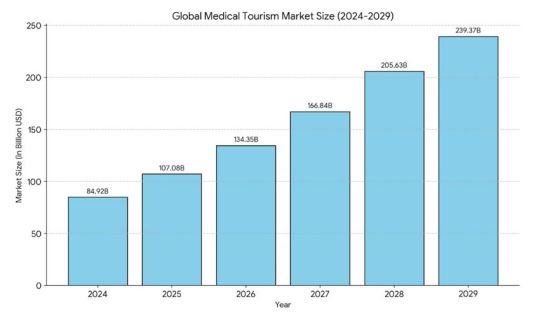
Factors Driving Growth:
Several factors contribute to the flourishing medical tourism market:
Cost-effectiveness: The significant cost disparity between healthcare services in developed and developing countries incentivizes patients to seek affordable yet quality healthcare abroad.
Increased Accessibility: Advances in technology and transportation have made international travel more accessible and affordable, facilitating medical tourism for patients across geographical boundaries.
Improving Quality Standards: Developing countries are heavily investing in healthcare infrastructure, leading to improved facilities, advanced technologies, and a skilled medical workforce, making them attractive destinations for medical tourists.
Aging Population: The rising global population and increasing life expectancy create a higher demand for healthcare services, including specialized procedures. Medical tourism offers an alternative for individuals facing long wait times or limited access to certain treatments in their home countries.
Medical Tourism Market Trends:
The medical tourism industry is experiencing several noteworthy trends:
Shifting Destination Landscape: While traditional destinations like Thailand, India, and Singapore remain popular, emerging players like Costa Rica, Malaysia, and the Philippines offer competitive pricing and high-quality care.
Rise of Specialization: Hospitals are increasingly focusing on specific specialties, such as cardiology, orthopedics, and fertility treatments, catering to the diverse needs of medical tourists.
Focus on Patient Experience: Providers prioritize patient experience by offering packages that include accommodation, transportation, language assistance, and post-treatment follow-up care.
Integration with Technology: The rise of telehealth consultations and online appointment booking systems streamlines the medical tourism process, making it more convenient and accessible for patients.
Growing Focus on Wellness: The boundaries between medical and wellness tourism are blurring, with patients seeking combined packages that offer medical procedures alongside wellness programs and spa treatments.
Wellness Industry Outlook:
The future of medical tourism industry appears promising, fueled by continuous growth and evolving trends. As healthcare costs rise, and patients become more aware of global treatment options, the demand for medical tourism is expected to remain robust.
However, challenges must be addressed to ensure the sustainable and ethical growth of the industry:
Regulation and Standardization: Ensuring consistent quality standards and ethical practices across healthcare providers and destinations remains crucial.
Patient Safety: Addressing concerns about potential risks associated with traveling for medical procedures and ensuring robust post-treatment follow-up is essential.
Transparency and Communication: Providing clear information about costs, procedures, and potential risks is crucial for building trust and creating positive patient experiences.
By mitigating these challenges and embracing evolving trends, the medical tourism industry can continue to provide patients with affordable, high-quality healthcare options and a unique opportunity to combine medical procedures with travel and cultural experiences.
#market research#business#ken research#market analysis#market report#market research report#medical tourism#medical tourism market share#medical tourism revenue#global medical tourism market#health tourism industry#medical tourism industry#medical tourism services#medical tourism market#tourism and hospitality industry#Wellness Tourism#medical tourism growth
1 note
·
View note
Text
How Nestabroad is Your Go-To for Hassle-Free US Visa Appointments?

Applying for a US visa is a major step for many people and families, and it is important to be prepared for this process. One of the critical stages of this process is the US visa appointment, which is a significant phase that defines the further course of the immigration process. At Nestabroad Immigration, they understand that visa processes can be quite challenging, and they help the applicants to overcome all these challenges.
What Is a US Visa Appointment?
An interview is a crucial stage of the visa application process for most categories of visas, and it involves a meeting with a US embassy or consulate officer. It entails making an appointment with the US embassy or consulate to give biometric data and go through an interview with a consular officer. This interview is a very important chance to prove that you are eligible and willing to follow the visa rules. Failure to make this appointment or handling it inappropriately can cause delays or denial of the loan, hence the need to handle this appointment with a lot of care and preparation.
Who Needs a US Visa Appointment?
It is important to note that most people who are not citizens of the United States need a visa to enter the country and therefore need a visa appointment. Regardless of whether you are applying for a tourist visa, student visa, or employment visa, this step is mandatory unless you are applying under the Visa Waiver Program or any other exceptions. It is therefore important to understand your visa category and the requirements that come with it to make sure that you do not encounter any problems when applying for the visa.
Common Categories of Applicants Who Need a Visa Appointment:
Tourists (B-2 Visa): Individuals visiting the US for leisure, tourism, or medical treatment.
Students (F-1 and M-1 Visas): Applicants pursuing academic or vocational studies.
Temporary Workers (H-1B, L-1, O-1 Visas): Professionals and skilled workers employed in the US.
Business Travelers (B-1 Visa): Those attending meetings, conferences, or other business activities.
Family-Based Applicants: Relatives of US citizens or permanent residents.
Importance of a US Visa Appointment
The visa appointment is not just a mere formality but a chance to market oneself as a worthy and reliable candidate. The decision made in this appointment usually dictates whether or not your visa application will be granted. It is always important to prepare and having the right help can go a long way. This is where Nestabroad Immigration comes in to help you with all the necessary paperwork and make sure everything is in order.
How to Schedule a US Visa Appointment?
Scheduling a US visa appointment involves a few key steps:
Complete the DS-160 Form: This online form collects your personal, travel, and security information.
Pay the Visa Fee: Payment varies depending on the type of visa you’re applying for.
Create a Profile: Register on the US Department of State’s visa appointment website to book your slot.
Select the Appointment Date: Choose an available date and location for your biometric submission and interview.
At Nestabroad Immigration, they simplify this process, making sure every detail is attended to so you can focus on your journey.
The Relevance of US Visa Appointments in Today’s World
Due to the high rates of global mobility, the US visa appointment has become very competitive as many people want to travel to the United States. Consular officers are more critical in assessing applications, and therefore applicants are advised to prepare well for the application and interview. Understanding these complexities can be daunting, but Nestabroad Immigration makes sure you’re equipped to meet the expectations confidently.
What Specific Documents Are Required for Each Type of Visa Application?
While the exact requirements vary by visa type, the following documents are typically required:
Passport: Valid for at least six months beyond your intended stay.
DS-160 Confirmation Page: With the barcode for tracking.
Visa Fee Receipt: Proof of payment.
Photograph: As per US visa specifications.
Supporting Documents: Vary by visa type (e.g., I-20 for students, job offer letters for workers).
Nestabroad Immigration provides detailed checklists corresponding to your specific visa category, so you’re fully prepared.
How Long Does the Entire Visa Appointment Process Typically Take?
The timeline varies depending on visa type and embassy/consulate location. On average:
DS-160 Processing: A few hours to a day.
Appointment Scheduling: 1-4 weeks, depending on availability.
Interview to Decision: Same day to several weeks.
By choosing Nestabroad Immigration, you’ll benefit from expert advice on expediting the process when possible.
What Happens If My Visa Application Is Denied, and Can I Reapply?
Denials can happen for various reasons, such as insufficient documentation or an inability to establish ties to your home country. If denied, you can reapply after addressing the reasons for denial. Nestabroad Immigration helps you identify these gaps, strengthens your application, and guides you through the reapplication process for a better outcome.
Why Choose Nestabroad Immigration?
Choosing the right immigration consultancy can make all the difference in achieving your goals. Nestabroad Immigration stands out for its:
Expertise: Years of experience in handling complex visa cases.
Personalized Service: Particular solutions for every client.
Reliability: Transparent processes and ethical practices.
Proven Success: A track record of satisfied clients.
With Nestabroad, you’re not just another applicant—you’re a valued client whose dreams matter.
About Nestabroad
Based in Nawanshahr, Nestabroad Immigration is a trusted consultancy offering a wide range of services, from student visas to permanent residency pathways. Their motto, “A new life begins with a new decision,” reflects their dedication to transforming your aspirations into reality. With a commitment to integrity, ethics, and continuous learning, they are your reliable partner in dealing with the complexities of immigration.
Conclusion
Securing a US visa starts with a successful US visa appointment, and Nestabroad Immigration is here to help you achieve this milestone with confidence. From document preparation to interview coaching, they’re with you every step of the way. Make the right decision today and let Nestabroad turn your immigration dreams into reality.
Contact them to get started on your journey!
Visit:
0 notes
Text
Cancer Biopsy Market: Future of Innovation and R&D Investments
The global cancer biopsy market is experiencing substantial growth, driven by the increasing prevalence of cancer and advancements in diagnostic technologies. Valued at USD 28.12 billion in 2023, the market is projected to reach USD 85.03 billion by 2032, exhibiting a compound annual growth rate (CAGR) of 13.0% during the forecast period from 2024 to 2032.
Get free sample report @ https://www.snsinsider.com/sample-request/1759
Market Overview
The rising incidence of cancer worldwide necessitates innovative diagnostic solutions for early detection and effective treatment. According to the National Cancer Institute's 2022 update, nearly 20 million new cancer cases were reported in the U.S. alone, with approximately 9.7 million cancer-related deaths globally. This alarming trend underscores the critical need for advanced diagnostic techniques, particularly liquid biopsies.
Regional Analysis
North America currently dominates the cancer biopsy market, attributed to its well-established healthcare infrastructure, high adoption of advanced technologies, and significant investment in research and development. Europe follows suit, benefiting from increased government initiatives promoting early cancer detection. The Asia-Pacific region is anticipated to witness the fastest growth, driven by a rising patient population, improving healthcare facilities, and growing awareness about early cancer diagnosis.
Market Segmentation
The cancer biopsy market is segmented based on:
Product: Instruments, Kits and Consumables, Services
Type: Tissue Biopsies, Liquid Biopsies, Others
Application: Breast Cancer, Lung Cancer, Colorectal Cancer, Prostate Cancer, Others
Key Players
QIAGEN
Illumina, Inc.
ANGLE plc
Hologic, Inc.
Biocept, Inc.
BD (Becton, Dickinson, and Company)
Myriad Genetics, Inc.
Thermo Fisher Scientific, Inc.
Genesystems, Inc. (Genesys Biolabs)
Danaher
F. Hoffmann-La Roche Ltd.
Lucence Health Inc.
GRAIL, Inc.
Natera, Inc.
Personalis Inc.
Guardant Health Inc.
Exact Sciences Corporation
Oncimmune
Epigenomics AG
HelioHealth (Laboratory for Advanced Medicine)
Freenome Holdings, Inc.
Biodesix (Integrated Diagnostics)
Chronix Biomedical, Inc.
Personal Genome Diagnostics Inc. and others.
Key Highlights
Technological Advancements: The emergence of liquid biopsy technologies offers minimally invasive diagnostic options, enhancing early detection and monitoring of various cancers.
Public Awareness Initiatives: Organizations like the CDC and WHO are actively promoting cancer screening awareness, particularly for cervical cancer, contributing to increased adoption of biopsy procedures.
Challenges: High costs of diagnostic tests pose challenges, especially in developing countries. However, the rise of medical tourism in nations such as India and Malaysia is providing more affordable diagnostic solutions.
Future Outlook
The cancer biopsy market is set to experience robust growth, propelled by technological innovations and heightened awareness of the importance of early diagnosis. The increasing adoption of advanced biopsy solutions by healthcare providers aims to improve cancer detection and treatment outcomes. Despite challenges like high diagnostic costs, the expanding availability of affordable solutions through medical tourism is expected to mitigate these issues, further driving market expansion.
Conclusion
The global cancer biopsy market is on a significant upward trajectory, driven by rising cancer prevalence, technological advancements, and proactive public health initiatives. As stakeholders continue to invest in research and development, the market is poised to achieve substantial growth, ultimately enhancing patient outcomes through early and accurate cancer detection.
Contact Us: Jagney Dave - Vice President of Client Engagement Phone: +1-315 636 4242 (US) | +44- 20 3290 5010 (UK)
Other Related Reports:
Pharmacy Benefit Management Market
Behavioral Health Software Market
Precision Medicine Software Market
#Cancer Biopsy Market#Cancer Biopsy Market Share#Cancer Biopsy Market Size#Cancer Biopsy Market Trends
0 notes
Text
The medical tourism industry is rapidly gaining popularity and is making a significant impact on the global economy. As more patients seek medical treatment abroad, the industry continues to expand, with medical tourism statistics indicating a steady increase in the number of medical travelers. By 2026, the global medical tourism market is projected to reach an impressive $143 billion, reflecting the growing demand for accessible and affordable healthcare options worldwide.
Rising Healthcare Costs and the Appeal of Medical Tourism
One of the primary drivers of the medical tourism industry's growth is the escalating cost of healthcare in many countries. As healthcare expenses continue to rise, patients are increasingly looking for more affordable alternatives. Medical tourism offers a compelling solution, allowing individuals to access high-quality medical care at a fraction of the cost they would incur in their home countries.
For instance, certain medical procedures can cost up to 70% less in countries like India, Mexico, and Thailand. This substantial cost savings not only helps patients manage their healthcare expenses but also makes essential medical treatments more accessible to a broader range of people. By choosing to travel abroad for medical care, patients can receive the treatments they need without compromising their financial well-being.
High-Quality Medical Facilities Abroad
Another factor contributing to the growth of the medical tourism industry is the increasing availability of world-class medical facilities in various countries. Many nations are investing heavily in their healthcare infrastructure, ensuring that patients can receive the same—if not better—levels of care as they would at home. This is especially beneficial for individuals living in rural areas or in countries where medical resources are limited.
The rise of high-quality medical facilities abroad has significantly enhanced the appeal of medical tourism. Patients now have access to advanced medical technologies, experienced healthcare professionals, and state-of-the-art treatment centers. These factors contribute to the growing confidence in medical tourism as a viable option for patients seeking both routine and specialized medical care.
Patient Satisfaction and the Medical Tourism Experience
Medical tourism statistics reveal that the majority of medical travelers are highly satisfied with their experiences. Patients often find that they can receive the medical treatments they need without sacrificing the quality of care or comfort. Additionally, the opportunity to explore new cultures and destinations adds a unique and enriching dimension to their medical journey.
The combination of excellent medical care, significant cost savings, and the chance to experience a different part of the world has made medical tourism an attractive option for many. As a result, the industry continues to thrive, with more patients choosing to travel abroad for medical treatments each year.
Economic Benefits and Job Creation
Beyond the benefits to patients, the medical tourism industry is also playing a crucial role in boosting local economies and creating jobs. As a multi-billion-dollar industry, medical tourism drives demand for Read Full Article From Here: https://wakelet.com/wake/_ZCJ1JXYImTn_ztZJLzfI
Watch Related Video:
youtube
youtube
youtube
youtube
Follow me for more info:
https://www.linkedin.com/in/medicaltourismbusiness
https://www.instagram.com/gilliamelliottjr/
#medical tourism business#medical tourism#medical tourism course#medical tourism consultancy#medical tourism certifications#medical tourism consultant#medical tourism facilitator certification#medical tourism training#medical travel#medical tourism industry#medical tourism training portal#Medical and Wellness Tourism Consulting#medical and global healthcare#healthcare facilitation#Medical and Wellness Tourism#medical tourism trends#Youtube
0 notes
Text
Medical Device Manufacturers In India
India's medical device industry is experiencing rapid growth, making it a key player in global healthcare innovation. With a strong manufacturing base, government support, and rising healthcare demands, medical device manufacturers in India are gaining prominence worldwide.
Growing Medical Device Industry in India
India ranks among the top medical device markets in the world. The sector is projected to reach driven by factors such as increasing healthcare investments, technological advancements, and a surge in medical tourism. The demand for high-quality, cost-effective medical equipment continues to rise.
Key Segments of Indian Medical Device Manufacturing
The Indian medical device sector covers various segments, including:
Diagnostic Equipment – Imaging systems, ECG machines, ultrasound devices.
Surgical Instruments – Precision tools, orthopedic implants, and endoscopy devices.
Hospital Furniture – Patient beds, ICU equipment, and stretchers.
Consumables & Disposables – Syringes, catheters, and medical gloves.
Implants & Prosthetics – Cardiac stents, knee replacements, and dental implants.
Leading Medical Device Industry in India
Several companies are contributing significantly to India's medical device sector. They specialize in diagnostic and imaging equipment, innovative medical devices, medical consumables, syringes, needles, advanced implants, and cardiovascular devices.
Government Initiatives Supporting Medical Device Manufacturing
The Indian government actively supports the medical device sector through initiatives such as:
Production-Linked Incentive (PLI) Scheme – Encouraging domestic manufacturing.
Medical Device Parks – Developing specialized zones for production and R&D.
Make in India & Atmanirbhar Bharat – Promoting self-reliance in medical equipment production.
GST Reduction on Medical Devices – Making healthcare products more affordable.
Challenges and Future Prospects
While the industry thrives, it faces challenges like regulatory compliance, dependence on imports, and pricing pressures. However, increasing investments in research, AI-driven diagnostics, and robotic-assisted surgery indicate a promising future.
Conclusion
India’s medical device manufacturers are revolutionizing healthcare with affordable, high-quality products. With government support and technological advancements, the country is set to become a global hub for medical device production. Businesses seeking reliable medical equipment suppliers should explore India’s thriving market.
0 notes